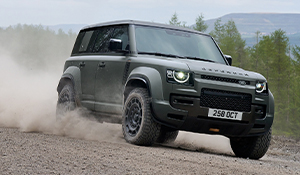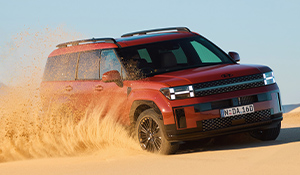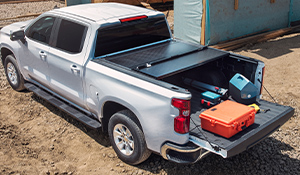26 off-road driving myths, busted!
RECEIVED WISDOM is advice passed down and then along. And almost nobody ever questions it, and more often than not the advice actually, kind of seems to make sense. Only mostly it's total rubbish, or stuff that was true during the middle ages, but not now...
Here are a few things that you often hear bandied about in off-roading circles that are wrong:
1. High tyre pressures help the tyre ‘cut down’ through mud to find traction – In some very specific cases that may be true, but mostly it’s not. High (road) pressure tyres will sink into the ground, which increases resistance to vehicle movement. Reducing tyre pressures will increase the effort required to turn the tyre as there is more tyre deformation, which is why high tyre pressures are used to reduce fuel consumption when driving on bitumen. However, reducing pressures when driving off road will increase the contact patch, meaning the tyre won’t sink in as far when on soft ground. That will outweigh the extra effort to turn the aired-down tyre; so in soft conditions air down to reduce rolling resistance. All this is explained by the science of terramechanics.
2. Don’t drop tyre pressures for rocks – The rationale here is that the tyre sidewall bulges out and will get damaged. In fact, the bulge is tiny and thus the increased risk of sidewall damage is tiny. On the other hand, reducing pressures makes the tyre softer and thus less prone to punctures; there’s less bouncing so better traction, and the tyre will grip odd-shaped rocks much better too. The tiny loss of ground clearance is well worth these advantages. In short, air down for rocks.
3. Wide tyres have a greater contact patch - Nope, same as narrow, just a different shape. Narrow tyres have a long and thin patch, whereas a wide tyre has a short but wide patch. Narrow tyres have lower rolling resistance than wide so are generally better for off-road driving and fuel economy. Wide tyres have better cornering grip, in general, but that's not because of a greater contact patch area.
4. Manuals are better than autos – True many, many years ago but no longer. Autos are just as powerful, are much easier to control at extremely slow speeds, and with gear reduction ratios like 1.45:1, and excellent disc brakes, hills are no longer a problem either.
5. Diesels are slow – Another one true a million-years ago, but a modern diesel is just about as powerful as a petrol, has a lot more torque (turning force) and several gear ratios to play with. Nowadays 0-100 times of sub-10seconds are not uncommon.

6. Traction control isn’t as good as locked diffs – The occasions when that can be said with confidence are becoming fewer and fewer, and traction control has notable advantages such as not restricting turning ability, placing less stress on the drivetrain and working automatically.
7. Drive with the centre diff unlocked in sand – The rationale here is that if one wheel starts to dig in then the others won’t. Which is true. Problem is that one wheel is now far, far more likely to dig in, and when it starts digging in, all the power will go to that wheel and make the situation worse. You’ll be stuck. It’s also dangerous on hills as the uphill wheels are more likely to lock than the downhill ones. If your 4x4 has a centre diff, lock it on sand. Simple.
8. Don’t ever brake downhill – Ideally, you wouldn’t ever brake on a downhill but if you’re going a touch too fast, or there’s enough traction ahead of a slippery patch then by all means gently apply a little brake pressure to slow things down. Don’t jab, and in general use the lowest gear possible.
9. Descend in neutral if first is too high – No. Not ever. Descending in neutral robs you of engine braking which increases the chances of a lock up and increases the chances of brakes overheating on long runs. There are various ways to descend a hill which are much safer.
10. Leaf springs are tougher than coils and you need leaves for weight – Well, that’d be why broken coils are such an issue then. Except they’re not, the modern coil spring doesn’t break very often and is extremely strong. You don’t need leaves for weight carrying either, as the likes of the Unimog and Defender 130 demonstrate. The reason leaves are fitted to utes is because they are cheap and the manufacturers are looking to save a buck - this isn't cost to buy aftermarket, it's OEM cost. Leaves are a spring and axle location system in one, vs a coil (or other spring) with lots of other complex systems to locate the spring.

11. Independent suspension is hopeless off-road – No, it’s not. In this age of superbly effective traction control lifting a wheel is no longer the end-of-momentum problem it once was, so the live-axle advantage of extra flex is reduced. On the other hand, less flex means the chassis remains higher off the ground, and independent suspension has greater under-body clearance with no diff centre to worry about. This isn’t to say independent suspension is better, just that it’s by no means necessarily worse than live axles and it’s very much situation-dependent.
12. Freewheeling hubs need to be unlocked for road use. If driving a vehicle with manual locking hubs it is fine to drive in on-road with the hubs locked and the transfer case in 2WD. Really. It is also fine to drive it off-road with the hubs in free and the transfer case in 2WD, but you won't get very far.
13. You can guess tyres pressures by looking. No you can't. Tyre pressure cannot be accurately assessed either by looking at the tyre or by feeling how hot it is to determine if it is overheating. If it looks flat, it's way too flat for any significant speed. Feeling the heat from the tyre is way too vague for lots of hopefully obvious reasons. Use a decent tyre pressure gauge, and look for a difference of 3-4 psi from cold (the vehicle sat stationary for a while) to hot (after about 20m of running). Keep the speed down if you run lower pressures.
14. Filling your tyres with nitrogen is a good idea - No, it is not.
15. You can fix windup by reversing straight back no, you can't. Driving in a straight line doesn't make the front driveshaft turn at a different speed relative to the rear.

16. Bridles halve the load - No, they don't. If you need 2000kg to drag your truck out of a hole, then you will be putting more than 1000kg of stress on each of your recovery points. How much depends on the angle of the bridle.
17. Adaptive automatics can be taught bad habits by your wife – It’s always the blokes with this one. Adaptive automatics learn shift points over minutes and do not have a memory any longer than the last part of the current drive. It's never clear exactly what habits people think their wives are teaching the car, but the myth persists.
18. Snatch blocks halve the load or double your pulling power - Any block has friction losses, so it's never going to be a perfect halving or doubling depending on how you look at it. But it is entirely possible to rig a block such that you get no mechanical advantage at all, and actually nearly double the load on your anchor point.
19. Traction control is no good in sand because it slows the vehicle down. The rationale here is that as a wheel spins the traction control brakes it, which slows the vehicle, then the opposite wheel spins and so on. That's not the case. Firstly, this is often a case of confusing stability control with traction control. But even if it isn't, think about what's happening. If a wheel is spinning then it's not doing much good on the traction front, and clearly its opposite number has more traction otherwise it would be spinning too. It may be that the driver has fallen for Myth 7, too. Anyway, slowing the spinning wheel and transferring torque to the wheel with greater traction will actually help maintain momentum. And as soon as the two wheel speeds on an axle are the same or close to it the traction control stops its braking, and won't restart unless there's a significant difference in wheel speed across an axle. This is a perspective myth, and while I cannot claim to have driven every vehicle in sand I have driven over 40 traction-controlled vehicles in soft sand and observed more on trips I have led, researched how the system works and in some cases where traction control has been a "problem" I have been able to trace the cause to unlocked centre diffs, driver error, stability control or overly high tyre pressures.
20. Warming the car up before you drive off is a good idea - No, it is not. Start it and drive it gently instead, and please don't idle for half an hour when parked at a campsite.

21. Run the same tyre pressures in your camper trailer as the tow car if the tyres are the same - Probably not. Tyre pressures are largely a function of weight. Do the maths - 3000kg car, 750kg per wheel. Say 1300kg trailer, 650kg per wheel. Now take off say 130kg for towball mass, leaving 585kg per wheel. Add that 130kg to the rear axle to make 815kg on the rear wheels, and we're down to 585kg on the trailer wheels. That's not even allowing for the fact that most 4WDs have more weight on the rear axle than the front, and leverage as a function of wheelbase vs distance from towball to centre of rear axle.
22. 4WD doesn't help you slow down - Mostly true. However, if you're engine braking, say in very slippery conditions, then you can engine brake on four wheels not two.
23. Mud tyres don't work in sand - They aren't ideal, but can certainly work very well. Tyre pressures are far more important.
24. You need a chunky tyre for off-road touring - No, you need a strong tyre of LT (light truck) construction. Sure, chunky mud-terrain patterns are a better bet off-road, but the combination of modern vehicles and modern tyres means today's vehicles can easily get places yesterday's struggled. But tyres remain the most fragile part of a vehicle, so use strong ones.
25. Tow ratings are real. No, not always.
26. Increasing rim width or tyre width increases track - Track is the distance between the centre of the tyres on an axle. You're thinking of overall car width. You want a change in track, change offset.
By Robert Pepper










